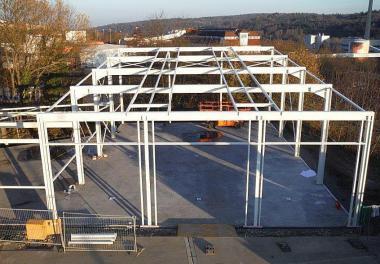Welding of S355M/ML with and without preheating
If the general requirements for welding steels as per DIN EN 1011-2 are observed, thermomechanical fine grain structural steels are just as or even better suited to welding than unalloyed structural steels. Due to their particular purity there is no or only very low susceptibility to lamellar fractures.
As with any steel, it is recommended to preheat any areas to be cut to 50°C if the product is wet or the temperature is below freezing. Excessive heat input should be avoided, as this may result in less favourable properties in the heat-affected zone (HAZ).
The weld area must be cleaned before starting the subsequent welding. Slag, scale and rust should be removed by brushing, grinding, or ideally by blasting.
Preheating not always used
In terms of manufacturing technology, thicker structural steels in particular must usually be preheated before welding. The preheating and interpass temperatures can be controlled using temperature measuring pins, magnetic thermometers, digital temperature measuring instruments or pyrometers. Drying or preheating must also be used to ensure that the weld area is moisture-free.
When using specially finished hot-rolled sections, preheating can generally be dispensed with completely. Using the QST (quenching and self-tempering) process at the end of the rolling mill produces a finer-grained microstructure with particularly high levels of strength and ductility but also an extremely low carbon equivalent value. This is done by cooling the section surface with a water jet. Because the core is not cooled, the section reheats the surface from within (self-tempering).
Steels of this special grade, such as those produced by ArcelorMittal under the brand name Histar, can be used with a European Technical Assessment (ETA). ETA -10/0156 [4], for example, regulates product properties in addition to DIN EN 10025-4 and provides additional instructions for working without preheating.

